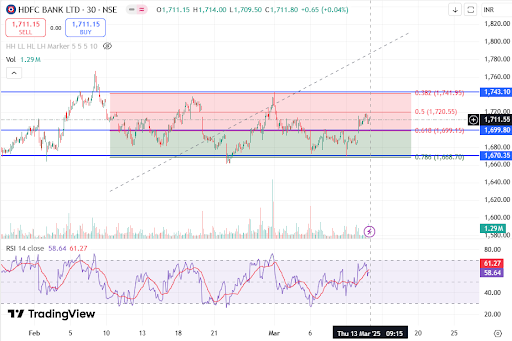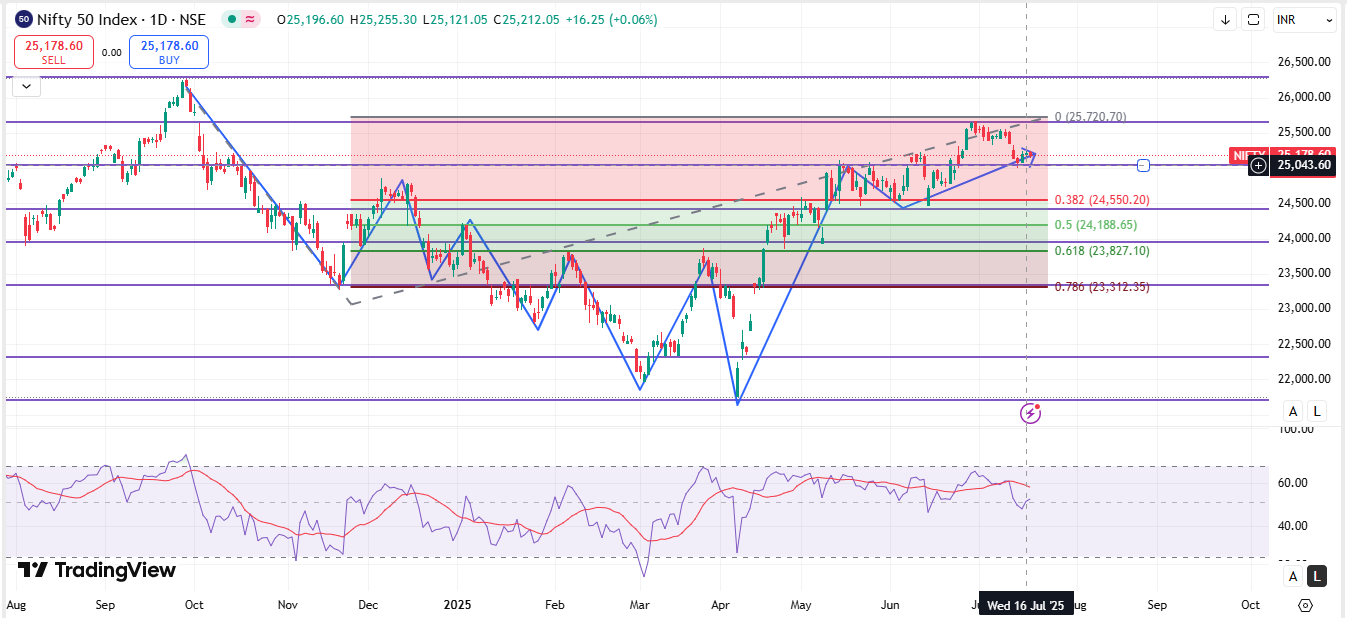Technical Analysis of HDFC Bank (30-Minute Chart)
Trend Overview:
The chart shows sideways consolidation after a downtrend, indicating a potential range-bound market.
The stock is trading near the 50% Fibonacci retracement level (₹1,720.55), which acts as a key resistance.
Support & Resistance Levels:
Support:
₹1,699.80 (61.8% Fibonacci level) – Key support level.
₹1,670.35 (Lower blue zone) – Strong demand zone.
Resistance:
₹1,720.55 (50% Fibonacci level) – Immediate resistance.
₹1,741.95 (38.2% Fibonacci level) – Major resistance.
₹1,743.10 (Upper blue zone) – Strong supply zone.
Target & Stop Loss Setup:
Bullish Scenario (Breakout Above ₹1,720-1,743)
Entry: Above ₹1,720 (on strong volume).
Target: ₹1,743 and ₹1,760.
Stop Loss: ₹1,699 (below 61.8% Fib level).
Bearish Scenario (Breakdown Below ₹1,699)
Entry: Below ₹1,699.
Target: ₹1,670 (next support).
Stop Loss: ₹1,720 (previous resistance).
Indicators & Confirmation:
RSI (Relative Strength Index):
Currently at 61.27, nearing overbought levels.
A move above 70 suggests overbought conditions, signaling a potential reversal.
Volume:
A breakout above resistance with high volume confirms strength in an uptrend.
A drop with increasing volume can confirm a bearish breakdown.
Final View:
If price breaks above ₹1,720 with volume, it can move towards ₹1,743+ (bullish).
If price fails at ₹1,720 and falls below ₹1,699, then ₹1,670 is likely (bearish).
Technical Analysis of HDFC Bank (30-Minute Chart)
Trend Overview:
The chart shows sideways consolidation after a downtrend, indicating a potential range-bound market.
The stock is trading near the 50% Fibonacci retracement level (₹1,720.55), which acts as a key resistance.
Support & Resistance Levels:
Support:
₹1,699.80 (61.8% Fibonacci level) – Key support level.
₹1,670.35 (Lower blue zone) – Strong demand zone.
Resistance:
₹1,720.55 (50% Fibonacci level) – Immediate resistance.
₹1,741.95 (38.2% Fibonacci level) – Major resistance.
₹1,743.10 (Upper blue zone) – Strong supply zone.
Target & Stop Loss Setup:
Bullish Scenario (Breakout Above ₹1,720-1,743)
Entry: Above ₹1,720 (on strong volume).
Target: ₹1,743 and ₹1,760.
Stop Loss: ₹1,699 (below 61.8% Fib level).
Bearish Scenario (Breakdown Below ₹1,699)
Entry: Below ₹1,699.
Target: ₹1,670 (next support).
Stop Loss: ₹1,720 (previous resistance).
Indicators & Confirmation:
RSI (Relative Strength Index):
Currently at 61.27, nearing overbought levels.
A move above 70 suggests overbought conditions, signaling a potential reversal.
Volume:
A breakout above resistance with high volume confirms strength in an uptrend.
A drop with increasing volume can confirm a bearish breakdown.
Final View:
If price breaks above ₹1,720 with volume, it can move towards ₹1,743+ (bullish).
If price fails at ₹1,720 and falls below ₹1,699, then ₹1,670 is likely (bearish).
Wait for confirmation through volume and RSI signals before entering a trade.
HDFC Bank, India's largest private sector bank, has demonstrated robust financial performance across various time horizons. Here's an analysis of its fundamentals:
Short-Term View (Next 6-12 Months):
Q3 FY2024 Performance: The bank reported a standalone net profit of ₹167.36 billion, aligning closely with market expectations. Net interest income grew modestly by 2% to ₹306.53 billion. However, there was a slight deterioration in asset quality, with the gross non-performing assets (GNPA) ratio increasing from 1.36% to 1.42%, primarily due to stress in agricultural loans.
REUTERS
Deposit and Loan Growth: Deposits grew by 4.2% to ₹24.53 trillion, outpacing loan growth, which stood at 0.9% to ₹25.43 trillion. This reflects a strategic focus on improving the loan-to-deposit ratio post-merger.
REUTERS
Medium-Term View (1-3 Years):
Post-Merger Integration: Following the merger with Housing Development Finance Corporation (HDFC) in July 2023, the bank's loan-to-deposit ratio spiked to 110%. The management aims to bring this ratio back to pre-merger levels of 86-87% within the next two to three years, indicating a focus on deposit mobilization and liquidity management.
REUTERS
Regulatory Environment: The Reserve Bank of India's measures to curb retail loans have led to increased provisions for bad loans among banks, including HDFC Bank. This necessitates a cautious approach to retail lending, impacting credit growth and profitability in the medium term.
FT.COM
Long-Term View (Beyond 3 Years):
Market Position: Post-merger, HDFC Bank's market capitalization reached $154 billion, making it the seventh-largest bank globally by this metric. The merger expanded its customer base to 120 million and increased its branch network to over 8,300 locations, solidifying its position as a dominant player in the Indian banking sector.
Growth Prospects: The bank's extensive distribution network and diversified product offerings position it well to capitalize on India's growing financial services market. Continued investments in digital banking and rural penetration are expected to drive sustainable growth in the long term.
Conclusion:
HDFC Bank exhibits strong fundamentals with a clear strategy to address short-term challenges and leverage medium to long-term growth opportunities. Investors may consider these factors when evaluating the bank's prospects across different investment horizons.
Fundamental View of HDFC Bank
HDFC Bank remains a fundamentally strong institution post-merger with HDFC Ltd. However, key factors such as loan growth, deposit mobilization, and regulatory challenges impact its short-term, medium-term, and long-term outlook.
Short-Term View (Next 6-12 Months)
🔹 Profitability & Asset Quality:
The bank’s Q3 FY24 net profit of ₹167.36 billion met expectations.
GNPA increased slightly to 1.42% from 1.36%, mainly due to stress in agricultural loans.
🔹 Loan & Deposit Growth:
Deposit growth (4.2%) outpaced loan growth (0.9%), indicating a focus on improving liquidity post-merger.
The loan-to-deposit ratio (LDR) is currently high (~110%), which the bank aims to normalize.
🔹 Regulatory Impact & Challenges:
The RBI’s restrictions on unsecured lending have led to higher provisions for bad loans.
HDFC Bank has reduced its exposure to the auto loan segment, which may slow credit growth.
🔹 Short-Term Strategy:
✅ Focus on stabilizing asset quality and improving deposit mobilization.
✅ Stock price may remain range-bound due to uncertainty in loan growth and asset quality.
Medium-Term View (1-3 Years)
🔹 Merger Synergies & Growth Outlook:
The HDFC-HDFC Bank merger has created a financial powerhouse, with an expanded customer base of 120 million+ and 8,300+ branches.
The bank aims to lower its LDR to 86-87% in the next 2-3 years, which will require strong deposit growth.
🔹 Retail & Digital Banking Expansion:
HDFC Bank plans to expand in semi-urban and rural areas, leveraging its strong brand presence.
The focus will be on increasing CASA (Current Account Savings Account) deposits and cross-selling financial products.
🔹 Regulatory Adjustments:
The bank must align with RBI’s stricter norms on risk-weighted assets and capital buffers.
If inflation remains under control, interest rate cuts by RBI could improve borrowing demand.
🔹 Medium-Term Strategy:
✅ Strengthening the balance sheet through higher deposit growth.
✅ Leveraging digital banking and fintech partnerships to boost profitability.
✅ Stock price likely to recover gradually, with improved credit growth and lower provisioning.
Long-Term View (Beyond 3 Years)
🔹 Market Leadership & Growth Potential:
HDFC Bank is now among the top 10 global banks by market capitalization (~$154 billion).
India's expanding middle class and digital economy will fuel long-term banking sector growth.
🔹 Focus on Rural & SME Lending:
Expanding lending to small businesses, agriculture, and retail customers will be key growth drivers.
The bank’s technology-driven approach will enhance cost efficiency and operational scalability.
🔹 Sustainable Earnings Growth:
The return on assets (ROA) and return on equity (ROE) will improve as merger integration is fully realized.
Continued economic growth in India will provide long-term support to the banking sector.
🔹 Long-Term Strategy:
✅ Focus on retail banking expansion and rural penetration.
✅ Technology and AI-driven banking solutions will enhance customer engagement.
✅ Stock price expected to show strong uptrend, with higher earnings growth.
Final Verdict
Short-Term: Volatile, with limited upside due to asset quality concerns and regulatory headwinds.
Medium-Term: Growth stabilizes as the bank focuses on deposit mobilization and merger synergies.
Long-Term: Strong upside potential as HDFC Bank consolidates its leadership in India’s banking sector.



No comments:
Post a Comment